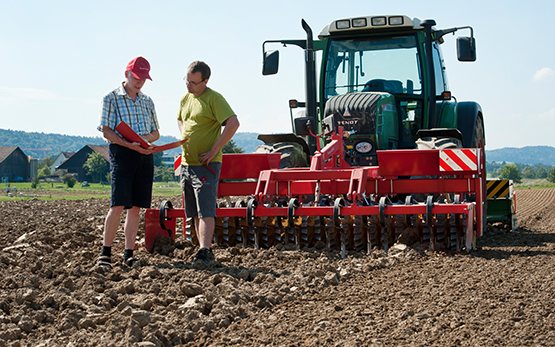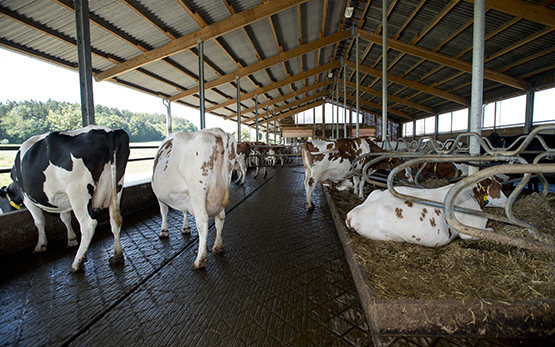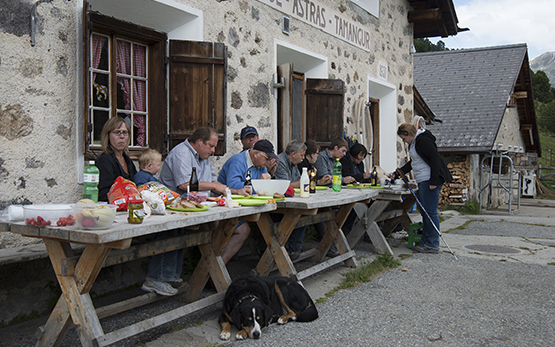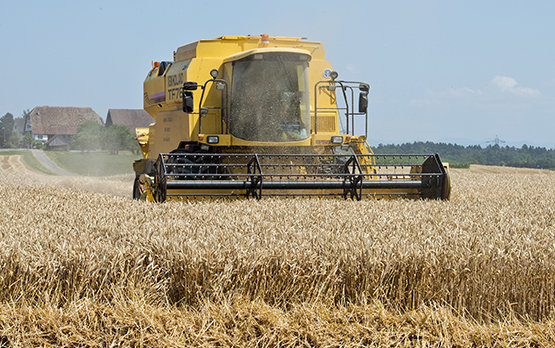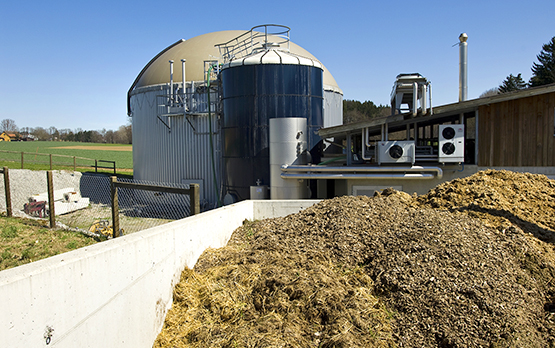Zosso C., Thiébaud E., Huber S., Bretscher D.
Landwirtschaftliche Treibhausgasrechner im Praxistest: Möglichkeiten und Grenzen.
Agrarforschung Schweiz, 15, 2024, 145-155.
Laubach J., Flesch T. K., Ammann C., Bai M., Gao Z., Merbold L., Campbell D. I., Goodrich J. P., Graham S. L., Hunt J. E., Wall A. M., Schipper L. A.
Methane emissions from animal agriculture: Micrometeorological solutions for challenging measurement situations.
Agricultural and Forest Meteorology, 350, 2024, 1-23.
Bretscher D., Grassnick n.
Chancen und Grenzen einzelbetrieblicher Treibhausgasbilanzierung in der Landwirtschaft.
In: Agrarforschung zum Klimawandel - Konferenz der Deutschen Agrarforschungsallianz. 7. März, Publ. Deutsche Agrarforschungsallianz (DAFA), Potsdam. 2024, 67.
Bretscher D., Hagemann N., Keel S., Leifeld J.
Pflanzenkohle.
Publ. Agroscope, Merkblatt Nr. 191, 2023, 4 pp.
other Languages: french | italian
Gorfer M., Borruso L., Deltedesco E., Gichuhi E., Menge D., Makihara D., Praeg N., Merbold L., Leitner S.
Plants and microbes respond differently to fertilization and environmental factors in a Kenyan rice field.
In: 3rd Global Soil Biodiversity Conference. 13-15 March, Publ. INRAE, Dublin. 2023, 338.
Leitner S., Carbonell V., Butterbach-Bahl K., Barthel M., Mhindu R., Mutuo P., Buchmann N., Merbold L.
Traditional livestock enclosures are greenhouse gas hotspots in the African savanna landscape: The case of a rangeland in Kenya.
In: EGU General Assembly 2023. 23-28 April, Publ. European Geosciences Union (EGU), Vienna (AT). 2023, 1-2.
Saunders M., Salmon E., Skjelvan I., Bornman T., Klausen J., Feig G., Merbold L., Kutsch W.
Designing a pan-African climate observation system to deliver societal benefit through climate action: The KADI project.
In: EGU General Assembly 2023. 23-28 April, Publ. European Geosciences Union (EGU), Vienna (AT). 2023, 1-2.
Merbold L., Odongo V., Dowling T., Fava F., Glücks I., Vrieling A., Wooster M., Leitner S.
Continuous observations of CO2 and CH4 exchange from East-African rangelands.
In: EGU General Assembly 2023. 23-28 April, Publ. European Geosciences Union (EGU), Vienna (AT). 2023.
Mwangi P., Eckard R., Gakige J., Marquardt S., Gluecks I., Mulat D., Merbold L., Pinares-Patino C.
Supplementation of sheep fed on a poor-quality grass with Calliandra sp. improves health and productivity, and reduces enteric methane emissions.
In: 11th International Symposium on the Nutrition of Herbivores (ISNH 2023). 4. - 8. June, Publ. Universidade Federal do Rio Grande do Sul and Universidade Federal de Santa Catarina, 2023, 606-607.
Mwangi P., Eckard R., Gluecks I., Merbold L., Mulat D., Gakige J., Pinares-Patino C., Marquardt S.
Impact of Haemonchus contortus infection on feed intake, digestion, liveweight gain, and enteric methane emission from Red Maasai and Dorper sheep.
Frontiers in Animal Science, 4, 2023, 1-16.
Bretscher D., Felder D., Zosso C.
Chancen und Herausforderungen einzelbetrieblicher Treibhausgasbilanzierung in der Praxis.
Publ. Bundesamt für Landwirtschaft BLW, 2023, 2 pp.
Dos Reis Martins M., Keel S.
Model simulation of N2O emissions from Swiss agricultural soils: Steps for upscaling.
In: LULUCF Soil Meeting. 18 October, Bern. 2023, 1-27.
Barczyk L., Kuntu-Blankson K., Calanca P., Six J., Ammann C.
N2O emission factors for cattle urine: Effect of patch characteristics and environmental drivers.
Nutrient Cycling in Agroecosystems, 127, 2023, 173-189.
Kay S., Zosso C., Bretscher D.
Wiederkäuer in der klimafreundlichen Landwirtschaft.
In: THeKLa- Treibhausgasbilanzierung und Klimaschutz in der Landwirtschaft -Jahrestagung 2023. 28. Juni, Braunschweig. 2023, 1-35.
Boss M., Meyer S.
Klimagerechte Produktion von Lebensmitteln: Wie können wir die Treibhausgasemissionen der Land- und Ernährungswirtschaft senken und trotzdem genügend produzieren?
In: Bäreggforum 2023. 22. März, Publ. INFORAMA Emmental, Bärau (BE). 2023.
Ndung'u P. W., du Toit C. J. L., Takahashi T., Robertson-Dean M., Butterbach-Bahl K., Merbold L., Goopy J. P.
A simplified approach for producing Tier 2 enteric-methane emission factors based on East African smallholder farm data.
Animal Production Science, 63, (3), 2023, 227-236.
Korir D., Marquardt S., Eckard R., Sanchez A., Dickhoefer U., Merbold L., Butterbach-Bahl K., Jones C., Robertson-Dean M., Goopy J.
Weight gain and enteric methane production of cattle fed on tropical grasses.
Animal Production Science, 63, (2), 2023, 120-132.
Stüssi M., Furrer C., Bystricky M.
LCA of greenhouse gas mitigations measures of farms.
In: 13th International Conference on Life Cycle Assessment of Food 2022 (LCA Foods 2022). 12. Oktober, Lima, Peru. 2022, 784-786.
Wolz K., Leitner S., Merbold L., Wolf B., Mauder M.
Enteric methane emission estimates for Kenyan cattle in a nighttime enclosure using a backward Lagrangian Stochastic dispersion technique.
Theoretical and Applied Climatology, 147, 2022, 1091-1103.
Wachiye S., Pellikka P., Rinne J., Heiskanen J., Abwanda S., Merbold L.
Effects of livestock and wildlife grazing intensity on soil carbon dioxide flux in the savanna grassland of Kenya.
Agriculture Ecosystems and Environment, 325, 2022, 1-14.
Ndung'u P. W., Takahashi T., du Toit C. J. L., Robertson-Dean M., Butterbach-Bahl K., McAuliffe G. A., Merbold L., Goopy J. P.
Farm-level emission intensities of smallholder cattle (Bos indicus; B. indicus–B. taurus crosses) production systems in highlands and semi-arid regions.
Animal, 16, (1), 2022, 1-12.
Salmon E., Jégou F., Guenet B., Jourdain L., Qiu C., Bastrikov V., Guimbaud C., Zhu D., Ciais P., Peylin P., Gogo S., Laggoun-Défarge F., Aurela M., Bret-Harte M. S., Chen J. and others
Assessing methane emissions for northern peatlands in ORCHIDEE-PEAT revision 7020.
Geoscientific Model Development, 15, (7), 2022, 2813-2838.
Graham M. W., Butterbach-Bahl K., du Doit C. J. L., Korir D., Leitner S., Merbold L., Mwape A., Ndung'u P. W., Pelster D. E., Rufino M. C., van der Weerden T., Wilkes A., Arndt C.
Research progress on greenhouse gas emissions from livestock in sub-saharan Africa falls short of national inventory ambitions.
Frontiers in Soil Science, 2, 2022, 1-18.
Korir D., Eckard R., Goopy J., Arndt C., Merbold L., Marquardt S.
Effects of replacing Brachiaria hay with either Desmodium intortum or dairy concentrate on animal performance and enteric methane emissions of low-yielding dairy cows.
Frontiers in Animal Science, 3, 2022, 1-15.
Heiskanen J., Brümmer C., Buchmann N., Calfapietra C., Chen H., Gielen B., Gkritzalis T., Hammer S., Hartmann S., Herbst M., Janssens I. A., Jordan A., Juurola E., Karstens U., Kasurinen V. and others
The integrated carbon observation system in Europe.
Bulletin of the American Meteorological Society, 103, (3), 2022, E855-E872.
dos Reis Martins M., Necpalova M., Ammann C., Buchmann N., Calanca P., Flechard C.R., Hartman M. D., Krauss M., Le Roy P., Mäder P., Maier R., Morvan T., Nicolardot B., Skinner C., Six J. and others
Modeling N2O emissions of complex cropland management in Western Europe using DayCent: Performance and scope for improvement.
European Journal of Agronomy, 141, 2022, 1-12.
Kupper T., Häni Ch., Bretscher D., Zaucker F.
Ammoniakemissionen der schweizerischen Landwirtschaft 1990 bis 2020.
Publ. Hochschule für Agrar-, Forst- und Lebensmittelwissenschaften HAFL, Zollikofen. 31. März, 2022
Lembrechts J.J., van den Hoogen J., Aalto J., Ashcroft M.B., De Frenne P., Kemppinen J., Kopecky M., Luoto M., Mclean I.M.D., Crowther T.W., Bailey J.J., Haesen S., Klinges D.H., Niittynen P., Scheffers B.R. and others
Global maps of soil temperature.
Global Change Biology, 28, (16), 2022, 3110-3144.
Bühler M., Häni C., Ammann C., Brönnimann S., Kupper T.
Using the inverse dispersion method to determine methane emissions from biogas plants and wastewater treatment plants with complex source configurations.
Atmospheric Environment: X, 13, 2022, 1-14.
Bystricky M.
Punkten für das Klima.
UFA-Revue, 5, 2022, 52-55.
other Languages: french
Zaman M., Kleineidam K., Bakken L., Berendt J., Bracken C., Butterbach-Bahl K., Cai Z., Chang S. X., Clough T., Dawar K., Ding W. X., Dörsch P., dos Reis Martins, M., Eckhardt C., Fiedler S. and others
Greenhouse Gases from Agriculture.
In: Measuring Emission of Agricultural Greenhouse Gases and Developing Mitigation Options using Nuclear and Related Techniques. Publ. Mohammad Zaman, Lee Heng, Christoph Müller, Springer. 2022, 1-10.
Monteiro E. de C., da Silva C. G. N., Dos Reis Martins M., Reis V. M., Boddey R. M., Alves B. J. R., Urquiaga S.
Strategy for the sampling of sugarcane plants for the reliable quantification of N2 fixation using 15N natural abundance.
Journal of Soil Science and Plant Nutrition, 21, 2022, 2741-2752.
Brümmer C., Rüffer J, Delorme J-P, Wintien P, Schrader F, Beudert B, Schaap M, Ammann C.
Reactive nitrogen fluxes over peatland and forest ecosystems using micrometeorological measurement techniques.
Earth System Science Data, 14, 2022, 743-761.
Zhu Y., Butterbach-Bahl K., Merbold L., Leitner S., Pelster D.
Nitrous oxide emission factors for cattle dung and urine deposited onto tropical pastures: A review of field-based studies.
Agriculture, Ecosystems & Environment, 322, 2021, 1-8.
Merbold L., Decock C., Eugster W., Fuchs K., Wolf B., Buchmann N., Hörtnagl L.
Are there memory effects on greenhouse gas emissions (CO2, N2O and CH4) following grassland restoration?
Biogeosciences, 18, (4), 2021, 1481-1498.
Yang L., Schallhart S., Taipale T., Tykkae T., Raesaenen M., Merbold L., Hellén H., Pellikka P.
Seasonal and diurnal variations in biogenic volatile organic compounds in highland and lowland ecosystems in southern Kenya.
Atmospheric Chemistry and Physics, 21, 2021, 14761-14787.
Leitner S., Ring D., Wanyama G., Korir D., Pelster D., Goopy J., Butterbach-Bahl K., Merbold L.
Effect of feeding practices and manure quality on CH4 and N2O emissions from uncovered cattle manure heaps in Kenya.
Waste Management, 126, 2021, 209-220.
Wachiye S., Merbold L., Vesala T., Rinne J., Leitner S., Räsänen M., Vuorinne I., Heiskanen J., Pellikka P.
Soil greenhouse gas emissions from a sisal chronosequence in Kenya.
Agricultural and Forest Meteorology, 307, 2021, 1-15.
Carbonell V., Merbold L., Diaz-Pienes E., Dowling T., Butterbach-Bahl K.
Nitrogen cycling in pastoral livestock systems in Sub-Saharan Africa: Knowns and unknowns.
Ecological Applications, 31, (6), 2021, 1-17.
Virkkala A.-M., Natali S. M., Rogers B.M., Watts J.D., Savage K., Connon S. J., Mauritz M., Schuur E. A. G., Peter D., Minions C., Nojeim J., Commane R., Emmerton C. A., Goeckede M., Helbig M. and others
The ABCflux database: Arctic-Boreal CO2 flux observations and ancillary information aggregated to monthly time steps across terrestrial ecosystems.
Earth System Science Data, 14, (1), 2021, 179-208.
Irvin J., Zhou S., McNicol G., Lu F., Liu V., Fluet-Chouinard E., Ouyang Z., Knox S. H., Lucas-Moffat A., Trotta C., Papale D., Vitale D., Mammarella I., Alekseychik P., Aurela M. and others
Gap-filling eddy covariance methane fluxes: Comparison of machine learning model predictions and uncertainties at FLUXNET-CH4 wetlands.
Agricultural and Forest Meteorology, 308-309, 2021, 1-22.
Merbold L., Scholes R., Acosta M., Beck J., Bombelli B., Fiedler B., Grieco E., Helmschrot J., Hugo W., Kasurinen V., Dong-Gill K., Körtzinger A., Leitner S., Lopez-Ballesteros A., Ndisi M. and others
Opportunities for an African greenhouse gas observation system.
Regional Environmental Change, 21, (104), 2021, 1-12.
Ndung'u P., Kirui P., Takahashi T., du Toit C. J. L., Merbold L., Goopy J. P.
Data describing cattle performance and feed characteristics to calculate enteric methane emissions in smallholder livestock systems in Bomet County, Kenya.
Data in Brief, 39, 2021, 1-11.
Zaman M., Kleineidam K., Bakken L., Berendt J., Bracken C., Butterbach-Bahl K., Cai Z., Chang S. X., Clough T., Dawar K., Ding W. X., Dörsch P., Dos Reis Martins M., Eckhardt C., Fiedler S. and others
Climate-smart agriculture practices for mitigating greenhouse gas emission.
In: Measuring emission of agricultural greenhouse gases and developing mitigation options using nuclear and related techniques. 30 January, Publ. Mohammad Zaman, Lee Heng, Christoph Müller, Springer, Cham. 2021, 303-328.
Zaman M., Kleineidam K., , Bakken L., Berendt J., Bracken C. , Butterbach-Bahl K., dos Reis Martins, M., Müller, C., Cai Z., Chang S. X., Clough T., Dawar K., Ding W. X., Dörsch P., dos Reis Martins M. and others
Methodology for measuring greenhouse gas emissions from agricultural soils using non-isotopic techniques: Chapter 2.
In: Measuring Emission of Agricultural Greenhouse Gases and Developing Mitigation Options using Nuclear and Related Techniques. 30 January, Publ. Zaman Mohammad, Heng Lee, Müller Christoph, Springer, Cham. 2021, 11-108.
Zaman M., Kleineidam K., Bakken L., Berendt J., Bracken C., Butterbach-Bahl K., Cai Z., Chang S. X., Clough T., Dawar K., Ding W. X., Dörsch P., Dos Reis Martins M., Eckhardt C., Fiedler S. and others
Isotopic techniques to measure N2O, N2 and their sources.
In: Measuring emission of agricultural greenhouse gases and developing mitigation options using nuclear and related techniques. 30 January, Publ. Mohammad Zaman, Lee Heng, Christoph Müller, Springer, Cham. 2021, 213-301.
Zaman M., Kleineidam K., Bakken L., Berendt J., Bracken C., Butterbach-Bahl K., Cai Z., Chang S. X., Clough T., Müller, C., Dawar K., Ding W. X., Dörsch P., Dos Reis Martins M., Eckhardt C. and others
Micrometeorological methods for greenhouse gas measurement.
In: Measuring emission of agricultural greenhouse gases and developing mitigation options using nuclear and related techniques. 30 January, Publ. Mohammad Zaman, Lee Heng, Christoph Müller, Springer, Cham. 2021, 141-150.
Zaman M., Kleineidam K., Bakken L., Berendt J., Bracken C., Butterbach-Bahl K., Cai Z., Chang S. X., Clough T., Dawar K., Ding W. X., Dörsch P., Dos Reis Martins M., Eckhardt C., Fiedler S. and others
Automated laboratory and field techniques to determine greenhouse gas emissions.
In: Measuring emission of agricultural greenhouse gases and developing mitigation options using nuclear and related techniques. Publ. Mohammad Zaman, Lee Heng, Christoph Müller, Springer, Cham. 2021, 109-139.


